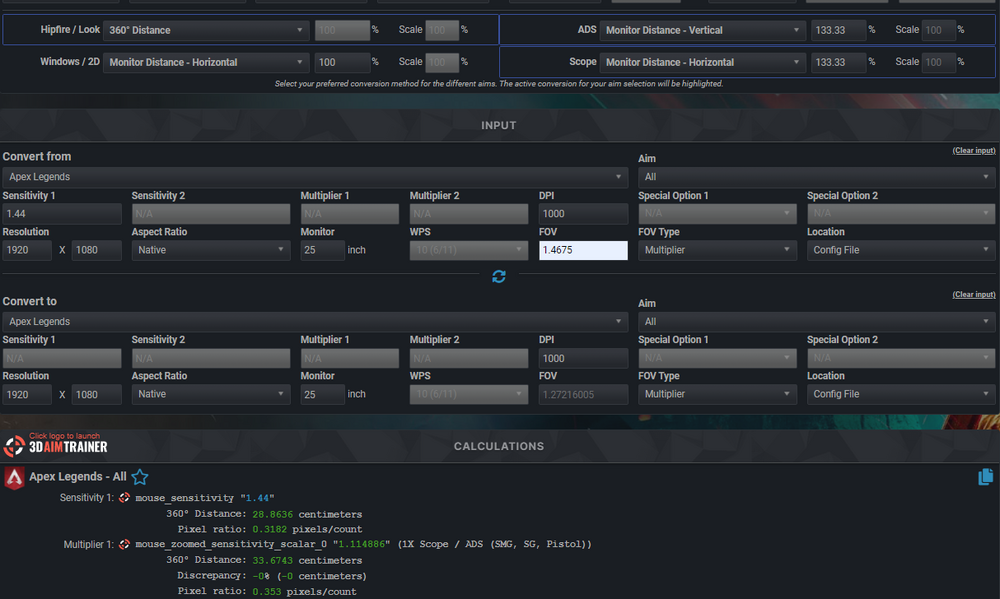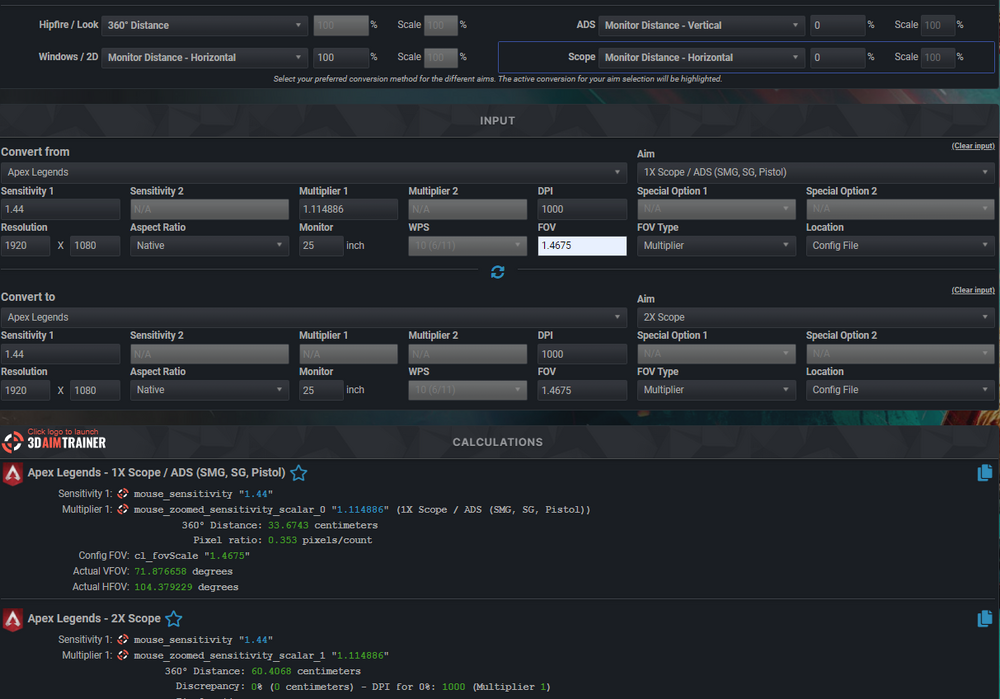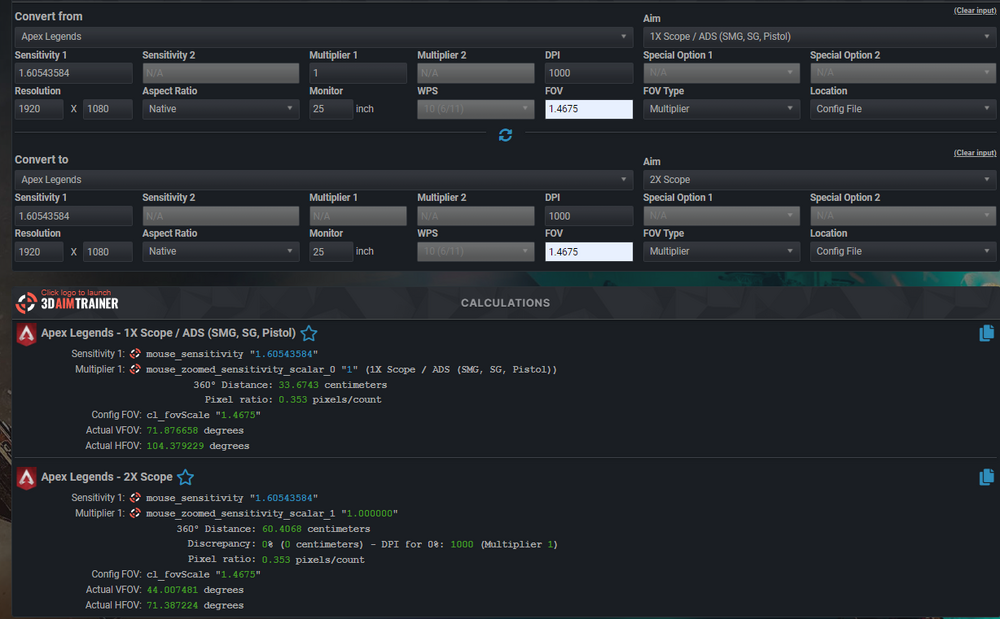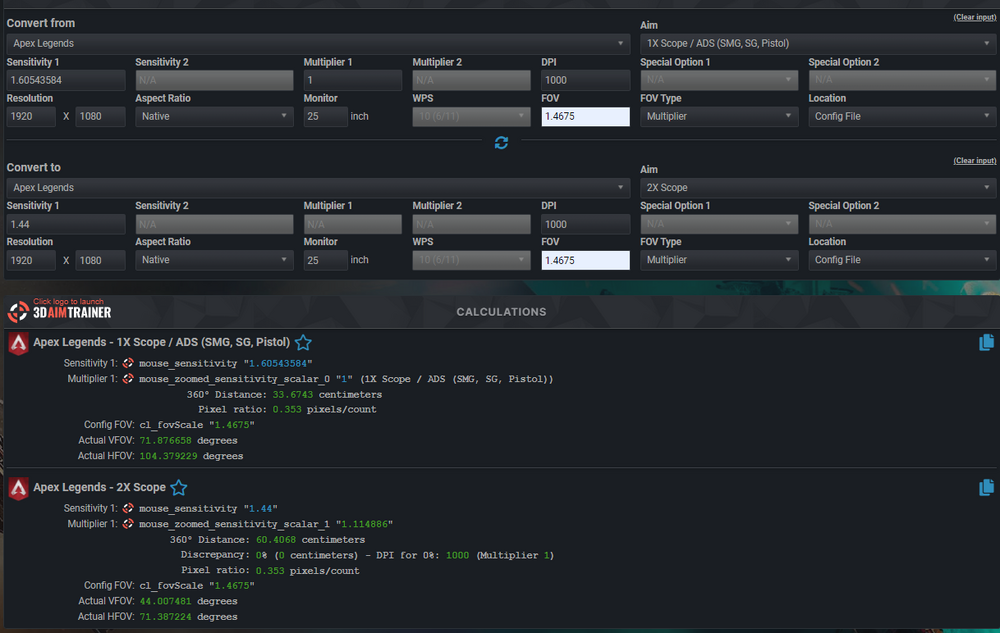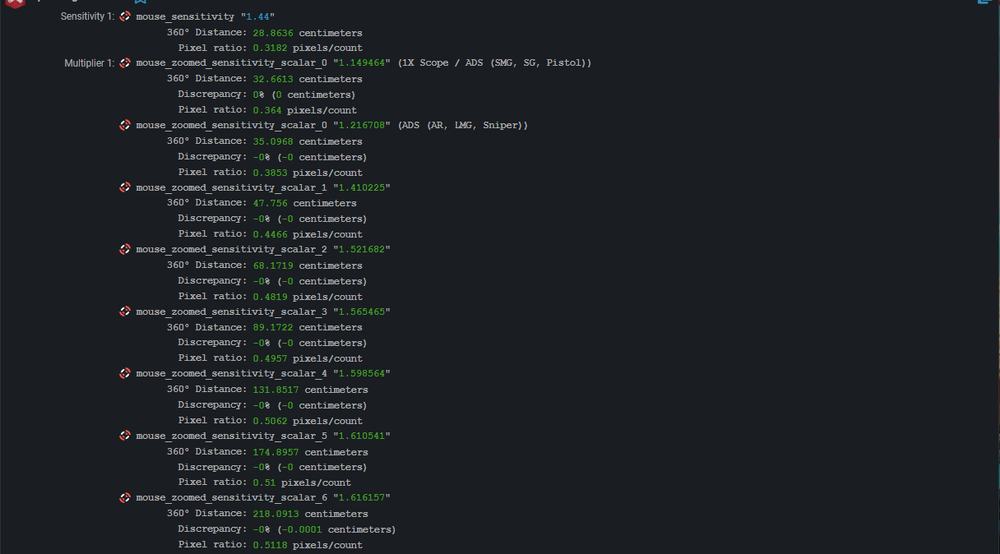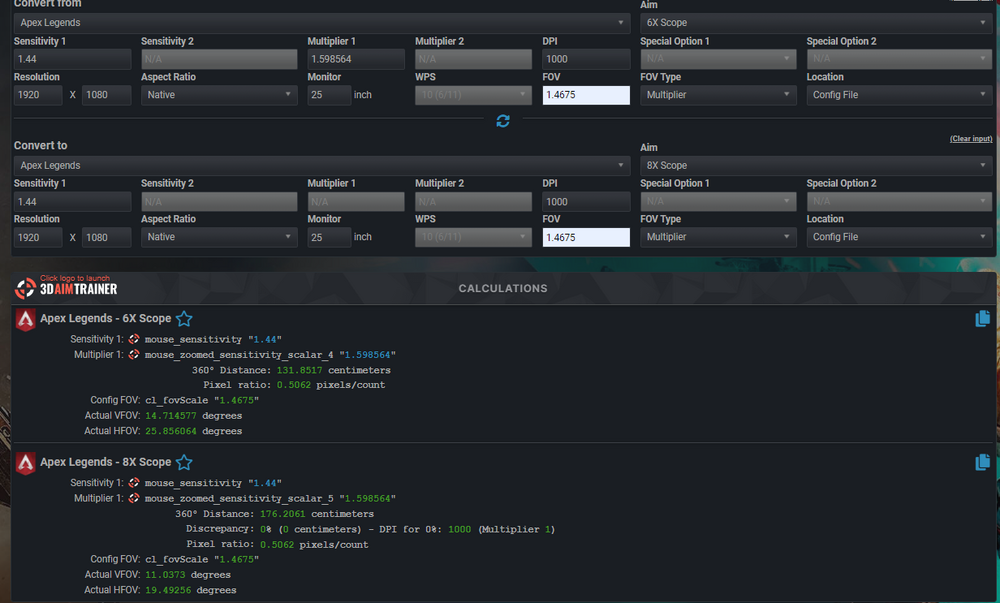
theferaltaint
Premium Members-
Posts
6 -
Joined
-
Last visited
Recent Profile Visitors
The recent visitors block is disabled and is not being shown to other users.
theferaltaint's Achievements
-
For the last few years, I have been on the hunt for my perfect sensitivity. I have tested all of the various conversion methods, even Jedi's and NoobPolice's dynamic matching. I have found both positives and negatives with all of the various approaches. None of them seem exactly right, and when converting from one game to the next, a lot of the time, things just feel completely different. This is even true using focal length scaling (0% MDH). I think all of these approaches have a flaw. Well, maybe not so much of a flaw per say, but fail to take something very important into consideration. An important variable is missing from these calculations (See "But...Something Else Is Missing" section. I think this has a lot to do with the type of games that are the most popular among sensitivity enthusiasts, and how they train their aim. I will need the help of those who are much better at the math of all of this than I am to help me figure out how to add in this missing variable. More on that further down. First, a quick overview of how all of this works, a couple of alternative approaches to applying focal length scaling for different games and play styles, and I will get to the missing variable at the end. We Typically Calculate Focal Length Scaling By: tan(Hip FOV/2) / tan(Zoom FOV/2) multiplied by Hip-fire cm/360 This will give us our hip-fire scaled ADS cm/360 for the optic with that specific FOV. Hip-fire Focal Length Scaling: A lot people complain (including myself) that when using 0% or focal length, you sacrifice your hip-fire accuracy since you usually have to increase your hip-fire sensitivity to compensate for the slower ADS speeds of 0% matching. Most of the people who are large proponents of focal length/0% monitor distance likely have numerous hours aim training with Kovaak's and play a lot of CS:GO, Valorant, Overwatch, etc. These games are not built around aiming down sights during gunfights, and some are based on stationary tracking/flicking, while others are based on moving while tracking. Hip-fire Stationary Tracking/Flicking: In both CS:GO and Valorant, moving while shooting punishes accuracy pretty severely, so usually when players flick or track an enemy, they are standing still or stop moving just before flicking to the target. It is for this reason that in many of the most popular scenarios in Kovaak's, the player is both stationary and flicks to targets using only hip-fire--zoom is often disabled. Hip-fire Mobile Tracking/Flicking: In games like Overwatch and older arena style shooters like Unreal Tournament, you track targets mostly with hip-fire while moving and jumping around. If you have spent thousands of hours training a specific hip-fire sensitivity at a specific FOV, focal length scaling from that hip-fire sensitivity and FOV makes sense. It will feel much less foreign since basically you are teleporting the character model forward and tracking with the same amount of mouse distance you would if you were that close to your target (more or less). However, if you have played games like Call of Duty, Battlefield, etc. you may find when you scale from the hip-fire sensitivity you normally use, everything is just way too slow. This is especially true if you have been using 1.33 or 1.78 monitor distance coefficient with zoom transition smoothing effects and all of that. You read about how good focal length scaling is for tracking and the consistency of your aim, but your aim just feels off. So what do you do? You crank your hip-fire sensitivity until your lowest zoom optic feels right again, but now, your hip-fire tracking and flicks are no longer consistent. This is especially true if you've done like I have and trained your aim both using hip-fire and while ADS to account for the difference in hand tension on the mouse and the different feel of the zoomed FOV's using monitor distance matching methods. This happens because your brain has more or less separated your hip-fire sensitivity and your most often used optic sensitivity. One for looking around and tracking things in the environment, and the other for engaging targets. There is also an in-between sensitivity during the zoom transition that is especially noticeable for those who ADS for initially accuracy and un-ADS to strafe faster during close quarters gun fights. So how do we remedy this problem? Well, I have tried different approaches. One that works decently well is accepting that you use two different sensitivities, and setting up your sensitivity that way. Though it falls short when it comes to the missing variable I mentioned initially. Bi-Sensitivity Focal Length Scaling: We don't "necessarily" have to scale from our hip-fire sensitivity. What we can do instead is take the hip-fire sensitivity and FOV we've grown accustomed to, use it as our first sensitivity. Now, we take our lowest zoom optic and find a sensitivity that allows us to flick easily from hip fire to ADS, flick while in ADS, and track while in ADS. You'll never find one that does all three perfectly at the same time. Settle for the one that you can do them all relatively well with. If you're coming from Battlefield or Call of Duty, and you've been using 1.33 or 1.78 MDV matching or 100% MDH from PUBG, just use the Mouse-Sensitivity.com calculator to calculate your low zoom optic sensitivity using the coefficient you're most comfortable with. This is your second sensitivity. Now, we can set the sensitivity for all other optics using focal length scaling/0% MDH. Apex Legends makes this easier to visualize since the game is using focal length scaling by default. Basically, you would just apply your second sensitivity calculation to all other optics. The same would be true in Call of Duty or Battlefield if you set the monitor distance coefficient or universal soldier aiming coefficient to 0%. You can think of this as a multiplier that is applied to your hip-fire sensitivity before focal length scaling is calculated, but without having to deal with the effects that would have on your hip-fire accuracy. For example: Hip-fire Sense = 1.44 ADS Sense or ADS Multiplier = 1.114886 True Focal Length Scale Hip-fire Sense = (Hip-fire)(ADS Multiplier) = (1.44)(1.114886) = 1.61 If we were to set our hip-fire sensitivity to 1.61 and our ADS sensitivity to 1.0 (0% MDH), we would have the same exact ADS sensitivity we do for our base 1.44 sensitivity for all optics only with a much faster hip-fire sensitivity. Tri-Sensitivity Focal Length Scaling: Using a multi-sensitivity approach to focal length scaling preserves your hip-fire accuracy while reaping the benefits of focal length scaling across all optics. For your lowest zoom optic, you can blend 100% MDH or 177.778 MDV that most people agree is best for flicking to the edge of the screen with focal length scaling to preserve tracking accuracy. However, I find this does not work as well for snipers. I prefer a much faster sniping sensitivity to better use snipers at closer ranges, so you can do a third calculation based off of something like 100% MDH and apply it across those like so: I choose one of the three sniper scopes. Here I chose the 6x. I take that sensitivity and apply it to both the 8x and the 10x. Now, when I zoom with a sniper scope, I get the consistency of that focal length teleportation forward across all three sniper optics based solely off of how the 6x feels. I guess we could call this Tri-Sensitivity Focal Length Scaling. To Recap: With Hip-fire Focal Length Scaling, you are only really mastering one sensitivity, but this is can be an issue when switching to games with ADS, fast strafing speeds, and fast paced movement. With Bi-Sensitivity Focal Length Scaling, you are mastering two sensitivities. One for movement, hip-fire tracking accuracy, and environmental navigation. And another that transitions well from hip-fire to ADS for flicking onto a target, flicking while ADS, and tracking targets. With Tri-Sensitivity Focal Length Scaling, you are mastering three sensitivities. The same two from Bi-Sensitivity Scaling, but with a third added for very long range optics allowing them to be used at closer ranges. We trade tracking accuracy for flicking speed and accuracy while maintaining focal length consistency across all of the long range optics. If you use the same conversion method for your 1x optic as you do for the sniper scope you choose, this will maintain the same "feel" of mouse movement to monitor distance between the two. This might be more helpful than trying to do a completely different calculation for your snipers (e.g. 75 MDH or 133.33% for your long range optic while using 100 MDH for your 1x). However, with all other approaches to monitor distance matching, you are technically having to master a new sensitivity for each optic and the transition sensitivities in between each and hip-fire. All that is actually consistent is the feel of the on-screen mouse movement and/or the view speed. This can theoretically be detrimental to your aim over time. I guess it all depends on how good you are at mastering new sensitivities. I change mine all the time, so I can adapt pretty fast. That said, the benefit to these is the consistent feel of mouse to monitor distance moved. This can work well in fast paced, fast TTK games where getting on target first wins the fight and tracking is less important. But...Something Else Is Missing: This is where I will need the help of those of you who are much more competent at figuring something like this out than I am. As I said above, focal length scaling and most of the concepts surrounding it assume that the player model is standing still. However, as you begin to strafe right or left, the distance your mouse needs to move to hit the target decreases or increases relative to how fast your strafe speed is and how far you strafe. What we cannot account for is the distance of your strafe since that would vary far too much to include in any kind of sensitivity scaling calculation. However, we can include the strafing movement speed in our calculation. What I have noticed, especially in games like Apex Legends with fast strafing speeds, focal length scaling starts to cause an issue somewhere between the FOV of the 2x and the 3x and forward. You almost need to increase it just slightly to account for the strafe. Everything is fine while you are standing still. Tracking is very easy. Recoil reduction via fast mouse movement in a specific direction helps even more. But once you strafe, you have to counter that with mouse movement. I do believe this is why so many people prefer 1.33 and 1.78. Not for the sake of tracking accuracy, but because it makes countering your strafe with your mouse much easier because it is consistently the same amount of mouse movement where with focal length scaling, it varies based on the distance of the target, the zoom FOV, AND your strafe speed relative to that distance. Developers address this problem on controllers via rotational aim assist (a weak low FOV aimbot more or less). This paired with focal length scaling is what makes controllers so incredibly strong in Apex Legends. With aim assist turned off on Apex Legends and without a monitor distance coefficient of some kind, controller players would have a very tough time tracking or staying on target since they cannot scale their input and have a limited range of motion. Even with a coefficient, it would be hard to track targets while strafing simply because the analog stick must cross the center before counter aiming can happen creating a delay. Moreover, you don't see as many people sniping with controllers in Apex Legends, mainly because focal length scaling has very very slow sniper scope speeds and due to the loss of aim assist strength at long distance. I am not sure how to go about calculating this, but I assume you could use strafing speed as form of smoothing and apply it over your focal length scaling sensitivity despite its origin (hipfire, 1x, etc.) thus avoiding the downside of monitor distance coefficients. Because technically, the "you only master one sensitivity" only applies while you are standing still. If you strafe towards your target, you are increasing your sensitivity relative to your target unless your target is moving in opposite direction at the same speed. If you strafe away from your target, you are decreasing your sensitivity, (we try to compensate for all of this via counter strafing). When both you and the target are moving inconsistently, this adds even more randomness to the equation causing your mouse movement requirements to vary wildly. However, as I said, we can't account for all of that randomness, but if we simply account for the base strafing speed, or an average across all of the movement speeds (running, walking, strafing, etc.), we would be able to smooth for the effect changes in momentum have on mouse movement required. It is honestly hard to ignore how much easier it is to strafe and shoot targets using monitor distance coefficients due to the consistency of mouse movement relative to on screen movement, but the impact these have on tracking at various ranges and other pitfalls mean if we can find a way to smooth for momentum over focal length scaling, this may create the best of all worlds. Calculus, trig, and physics were a very long time ago for me. This is probably entirely wrong, but one way I could think of doing it would be to take the maximum movement speed (running) and determine what percentage of that speed is strafing. Let's say we run at 10 mph and strafe at 1 mph. Strafing is 10% of the maximum movement speed. We won't be firing while running so that speed is more or less irrelevant. We can then say if we strafe away from the target, that decreases our sensitivity by 10%. If we strafe towards the target, that increases our sensitivity by 10%. Simply increasing our sensitivities across the board by the average of the two would do nothing. Plus, the mean of those is zero unless you calculate a geometric mean. You would have to account for the change in FOV relative to the change in momentum. I have absolutely no idea how to even begin to do that. Of course, when you do this, you'll lose a bit of the benefit of focal length scaling, but in return you will be accounting for the average range of momentum shifts while strafing and while standing still whether ADS or not. Anyone have any ideas???? @TheNoobPolice @MacSquirrel_Jedi @DPI Wizard
-
Monitor Distance - Dynamic is now live!
theferaltaint replied to DPI Wizard's topic in Technical Discussion
@TheNoobPolice Man this more or less equals out to what I've been trying to do forever. -
COMBINING MONITOR DISTANCE COEFF W/ ADS MULTIPLIERS
theferaltaint replied to theferaltaint's topic in Technical Discussion
Could you link me to this thread. Always interested to try out new methods.- 4 replies
-
- monitor match
- sensitvity
-
(and 3 more)
Tagged with:
-
 theferaltaint reacted to a post in a topic:
COMBINING MONITOR DISTANCE COEFF W/ ADS MULTIPLIERS
theferaltaint reacted to a post in a topic:
COMBINING MONITOR DISTANCE COEFF W/ ADS MULTIPLIERS
-
COMBINING MONITOR DISTANCE COEFF W/ ADS MULTIPLIERS
theferaltaint replied to theferaltaint's topic in Technical Discussion
@DPI Wizard Would love to get your take on this.- 4 replies
-
- monitor match
- sensitvity
-
(and 3 more)
Tagged with:
-
This is more or less a conceptual question/proposal for those of you who have been working with methods of mouse sensitivity calculations across various in-game FOV's for many years now. Personally, I have tried all of the different conversion methods and coefficients. There are pros and cons to each one for me specifically. That's beside the point. My question for you guys is: Do you think that an ADS multiplier applied to let's say 0% vertical monitor distance would provide more aim consistency than increasing the coefficient to 133% if you find 0% to be a little too slow and do not want to increase your base hipfire sensitivity? That way the increase in "turning speed" is consistent across all FOV's, and is simply applied over the monitor distance calculation? You are not changing the point on the screen at which the matching has been calculated per say. You are simply multiplying all matched values by another number thus increasing each by the exact same amount. For example: 1.06(0% MDV of 1x optic), 1.06(0% MDV of 2x optic), and so on and so forth. Also, if you wanted high magnification optics to be much faster than lower magnification optics, would it not be better to just increase the multiplier rather than the coefficient? For example: 1.33(0% MDV of 6x optic), 1.33(0% MDV of 8x optic), and so on and so forth. The "monitor distance match" more or less remains the same. The way I see it, all you're doing is increasing the speed at which the center of the screen reaches that point without effecting that underlying monitor match consistency across all FOV's, but I could be entirely wrong about that. This is the approach to ADS sensitivity that I've found works best for me. When I try to increase the monitor distance match to increase speed, my aim across all FOV's feels way off. They all feel way too fast. Rather than adjusting my monitor distance with each game, I just change the multiplier until it all feels right, and my tracking/flicking is as accurate as possible. For example, on Modern Warfare/Warzone, I use 133% MDV match with a 1.06 multiplier on the low zoom optics, and a 1.33 multiplier on the higher zoom optics. On Apex Legends, I am currently using 133% MDV match with a 1.03 multiplier across all optics, though I have also used 1.06 on low and 1.33 on high magnification in the past. Again, I am just curious to know what you guys think about this.
- 4 replies
-
- monitor match
- sensitvity
-
(and 3 more)
Tagged with:
-
@DPI Wizard I see that there is a vertical sensitivity value in the config. Scaled is set to 20 and unscaled to 100. Have you tested to see if this value needs to be changed to have a true 1:1 horizontal/vertical sense?

